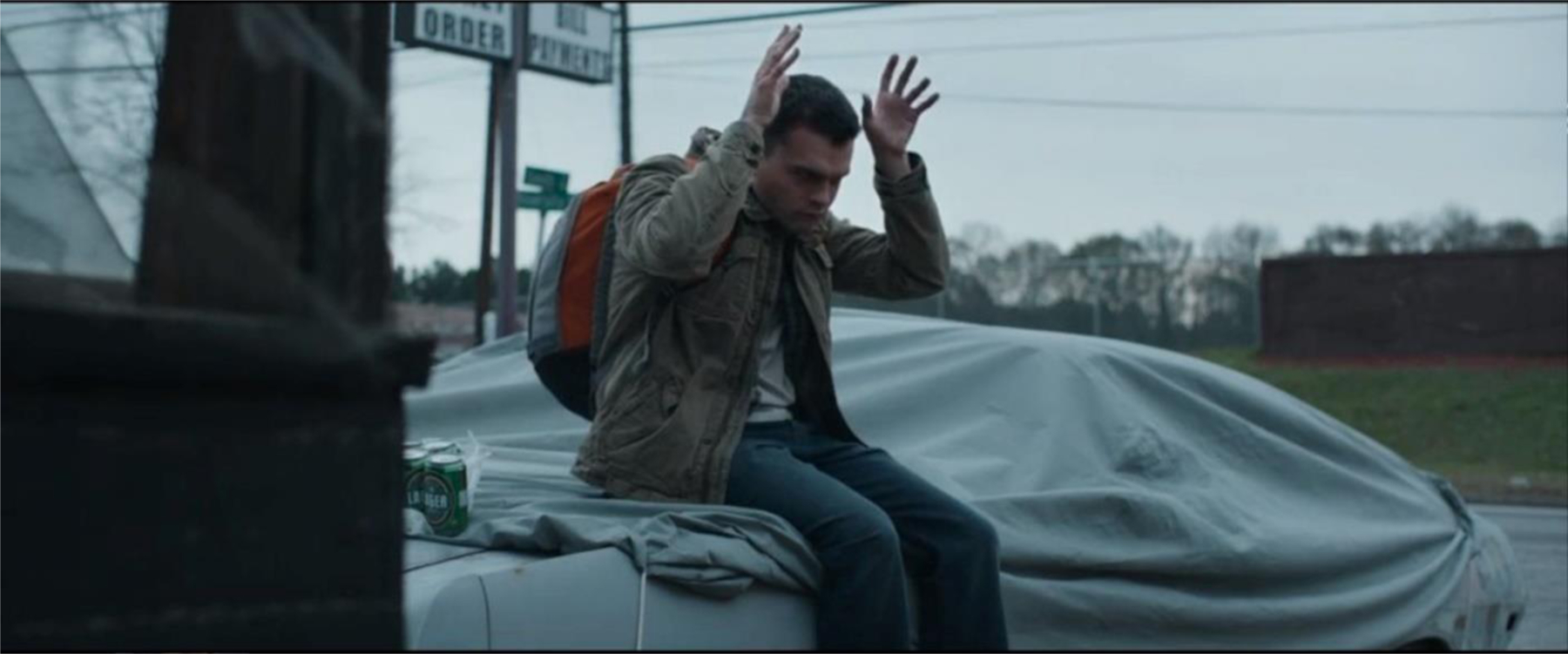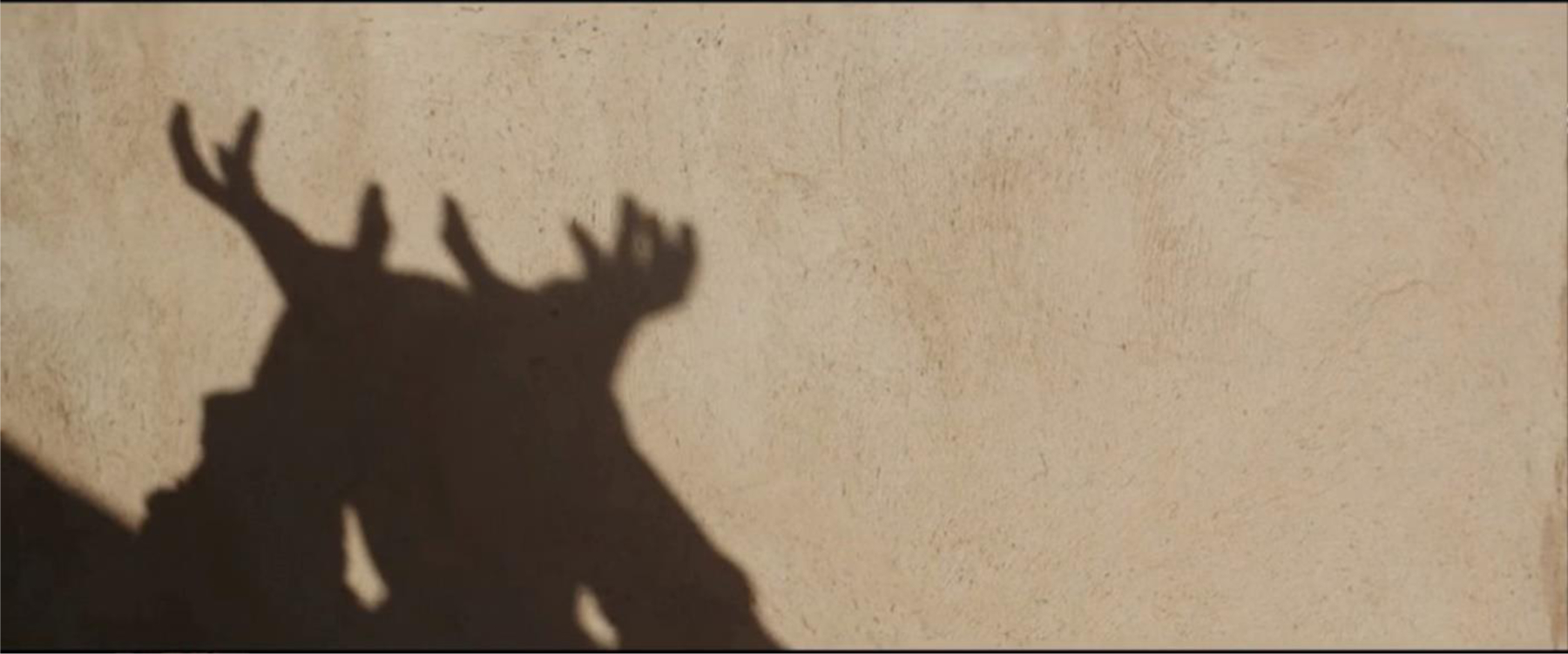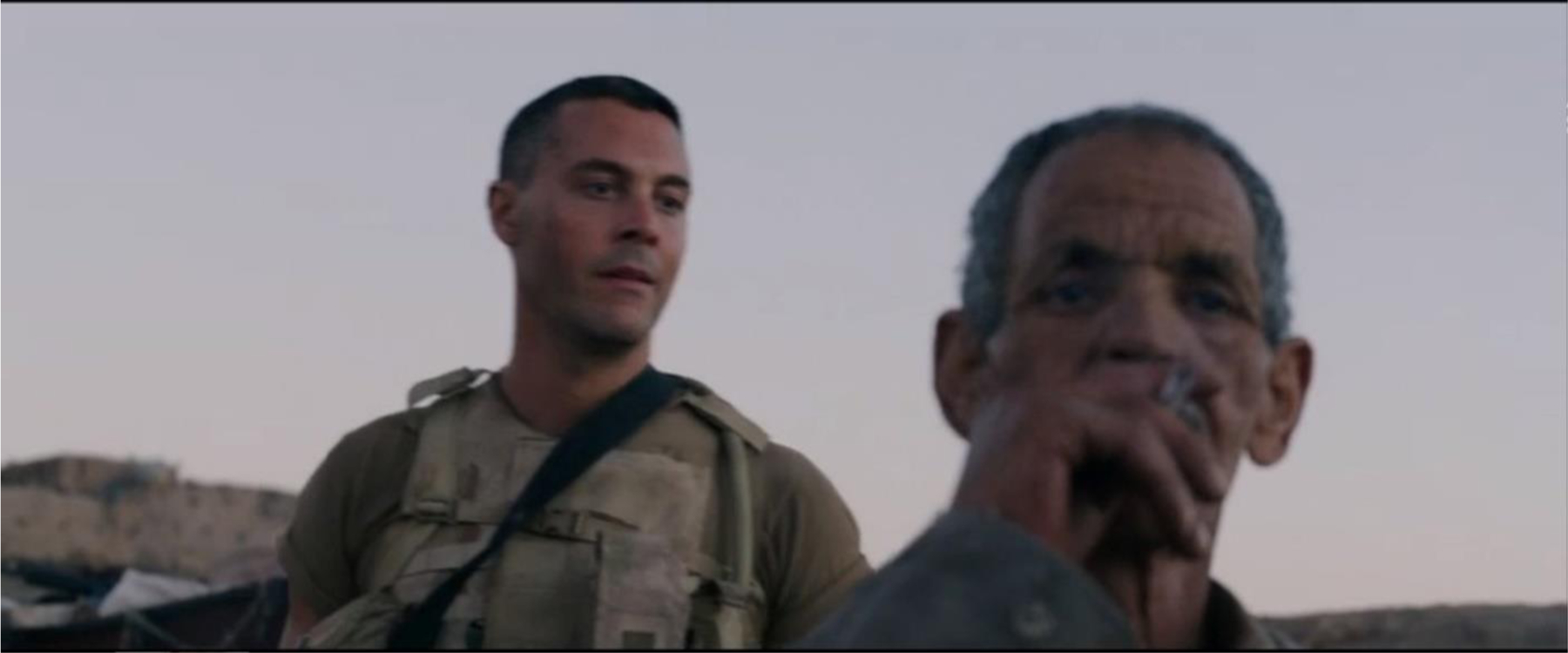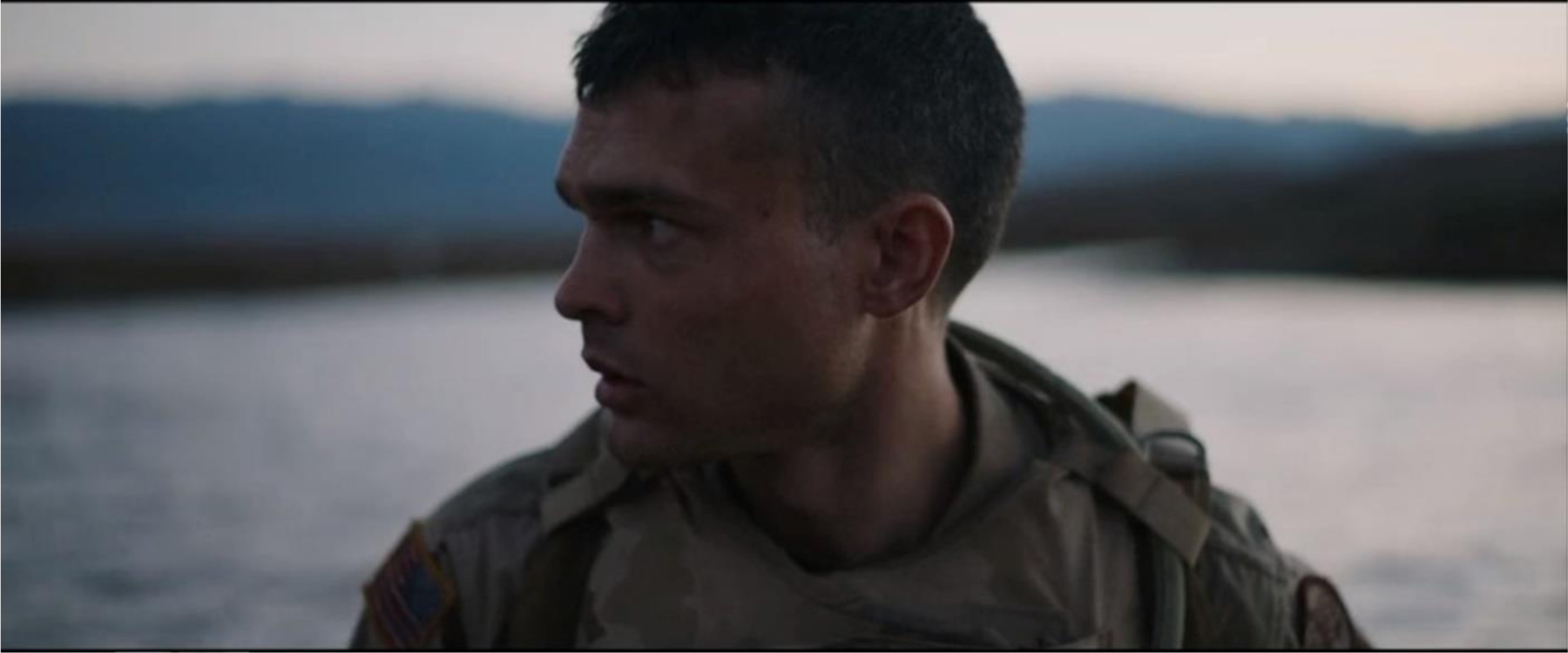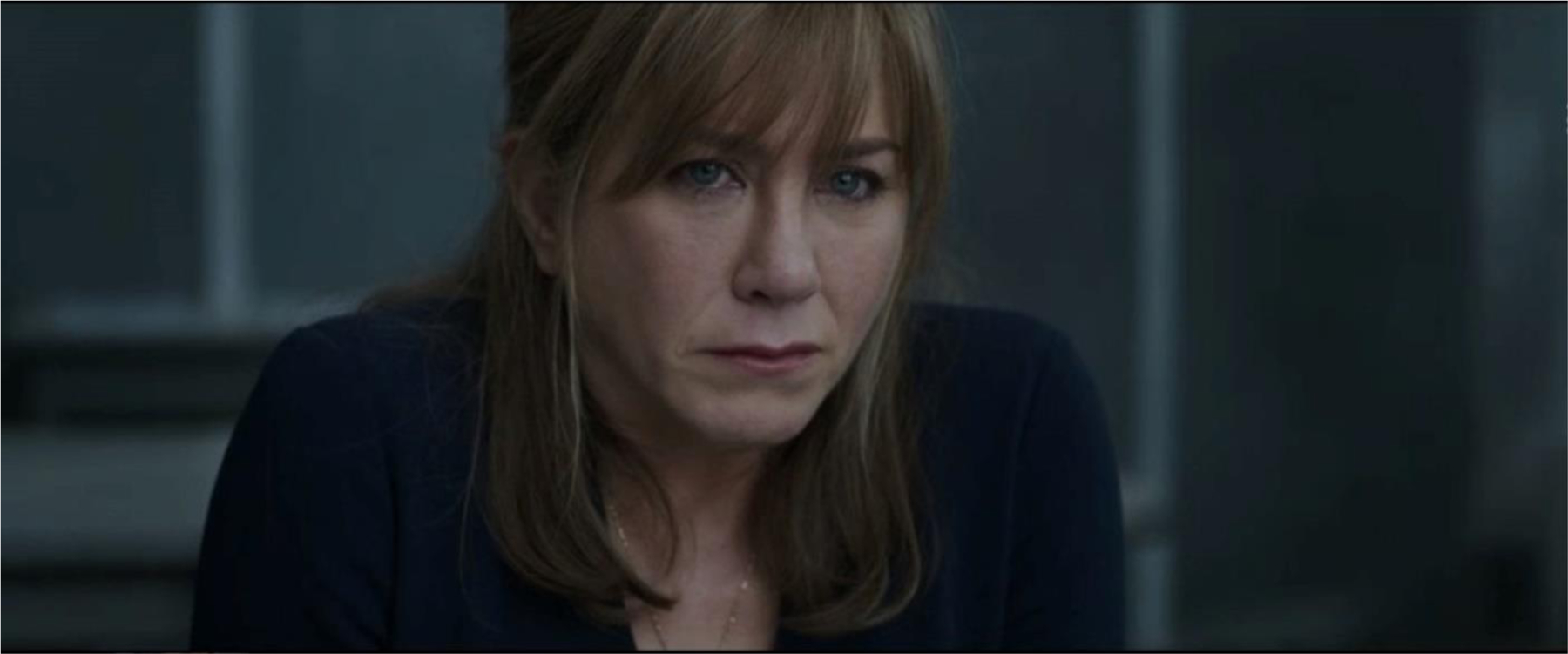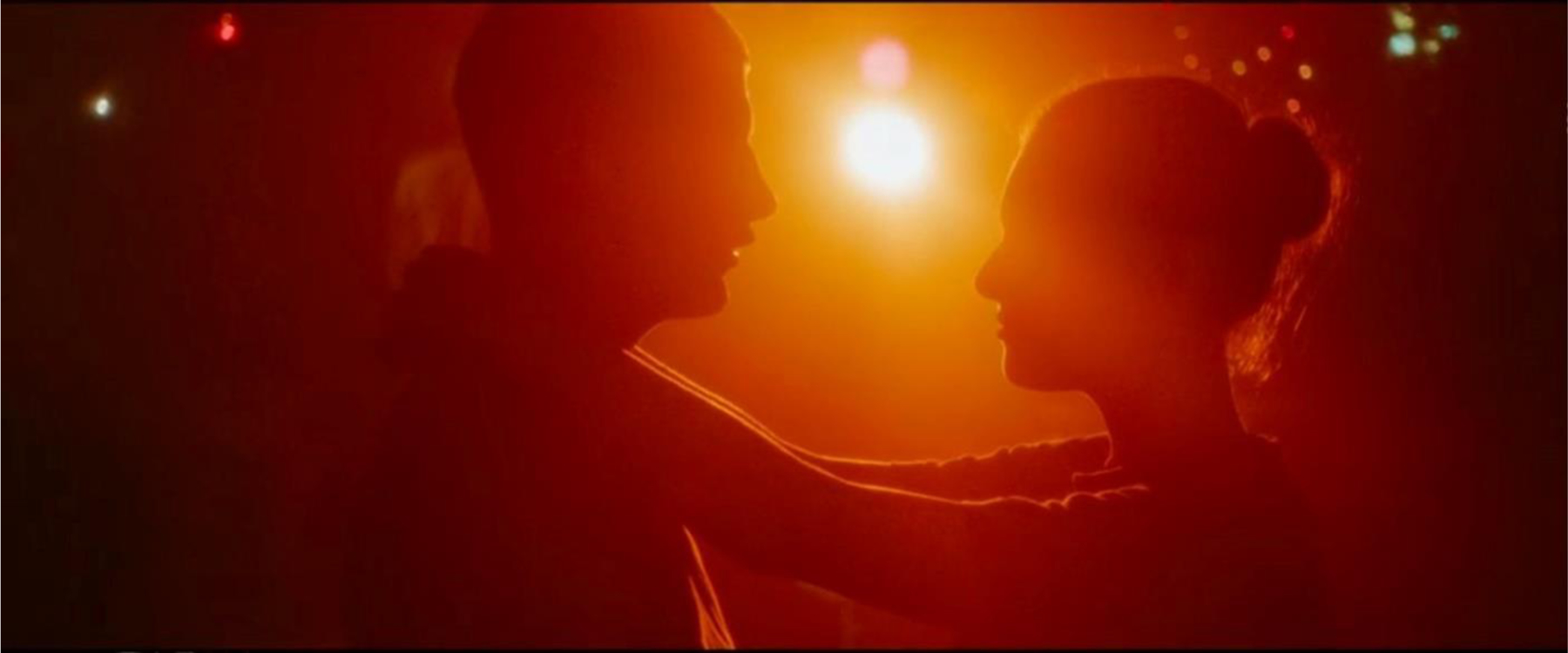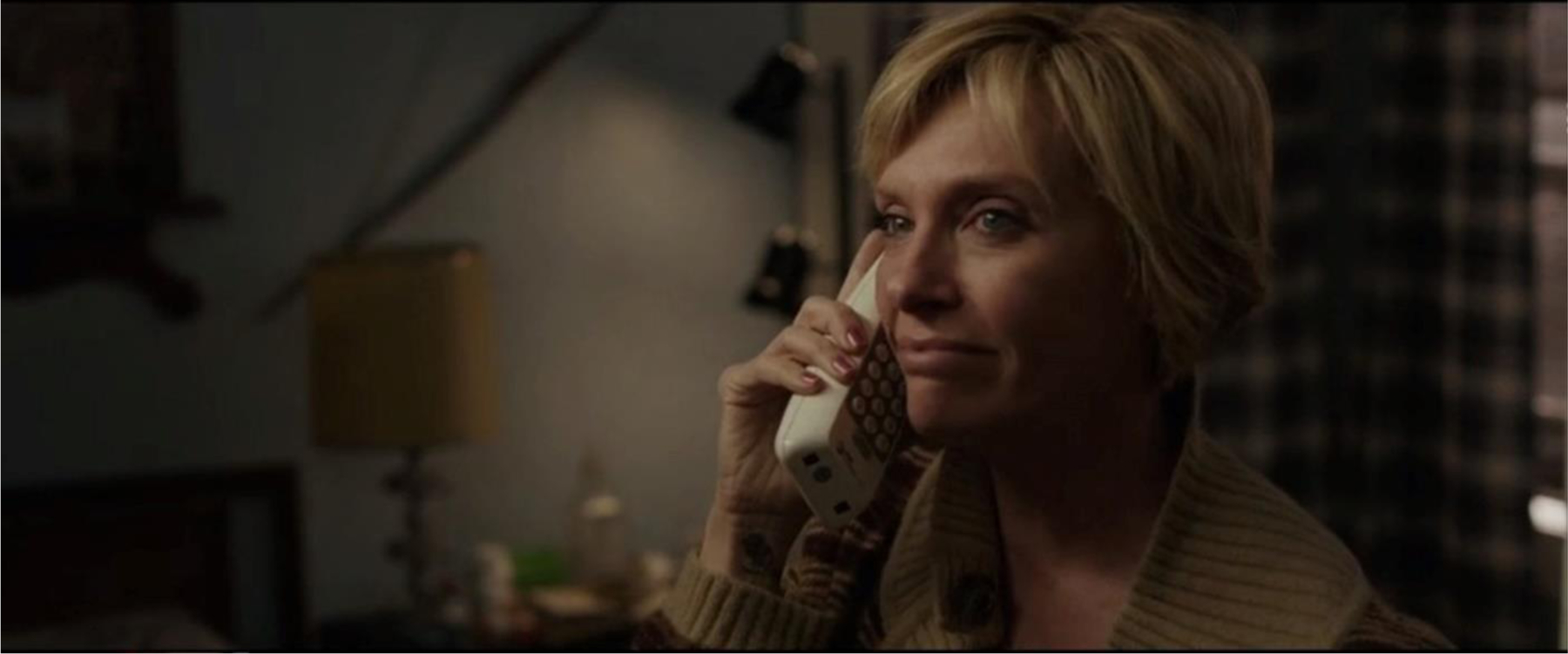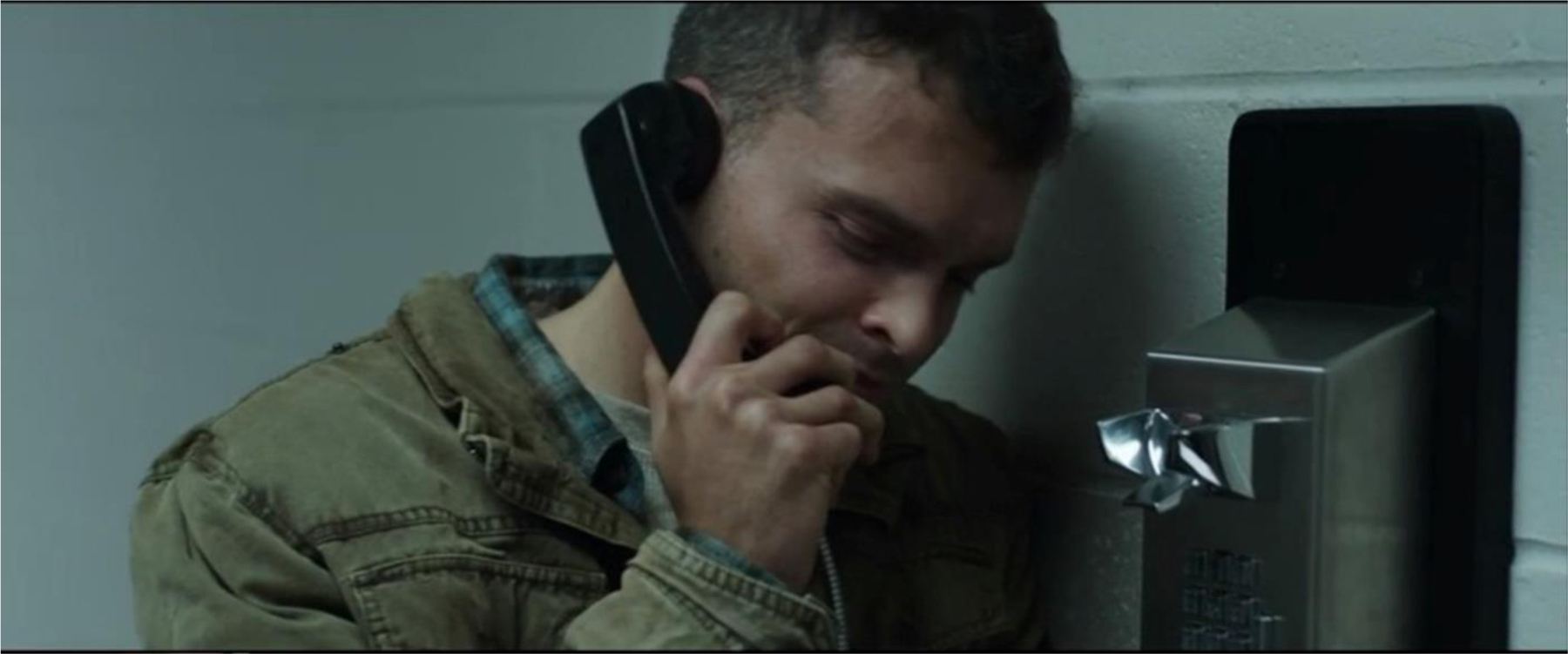Combat veterans in contemporary cinema are often silent. It’s not just that they rarely speak about the war; they typically have less dialogue overall than other characters, even as they appear in many scenes of the film and are often at the center of it. For Bartle, the protagonist of The Yellow Birds (Alexandre Moors, 2017), based on a novel of the same name by Kevin Powers (2012), silence is a survival tool during training; early on, for instance, he urges Murph, who will eventually become his best friend, to be quiet lest their sergeant hear them talking while they’re loading clips on the firing range. Silence for the post-war Bartle, however, is different, bound up not just with the combat he takes part in, but also with guilt, both for Murph’s death and for a war crime that the film gradually reveals. And while not every contemporary film about returning veterans has a war crime at its center—many such films, in fact, emphasize the veteran’s heroism—almost all cinematic combat veterans begin the film in silence.
This silence is but the first step in a remarkably consistent generic arc: the cinematic veteran, returned to the United States, is characterized by silence; the narrative works toward a moment, either positioned as the climax or very nearly there, where the veteran tells their story; the story is told to a listener who often directly elicits the story; and once this story is told, the narrative implies a healing of wounds, with a promise of the veteran rejoining the community, often through the listener. (The consequences of not telling the story result in a different outcome, as we will see.) This arc is also one that we find in cinematic veterans on screen in earlier eras; Keith Beattie, whose work I discuss at greater length below, has traced out the Vietnam Veteran’s movement from silence to speech in narrative representation.1 But whereas for Beattie’s Vietnam Veteran, that transformation took years, the contemporary arc takes a mere two hours, and it occurs every time we view the films. And even if this was true for some earlier films as well, the consistency of the contemporary arc within a feature-film time-frame bears scrutiny here.
This essay will trace out this arc, and explore each stage of it, within a single film: The Yellow Birds. By examining The Yellow Birds, my hope is that it might bring us a bit closer to understanding the stories we are telling ourselves about military veterans returning from contemporary U.S. wars. In doing so, I hope to begin shedding light on the ways we view those veterans, the ways we view those wars, and the truth and lies we tell ourselves about both.
Silence
What I’m calling the veteran’s silence, to be clear, is not so much the total absence of speech as it is a quality of speaking much less than other characters, and I would suggest there are at least three ways to understand this silence, related but worth considering discretely:
As a sign of trauma and/or guilt a veteran carries within an initial inability to articulate the severity of the war experience;
As a reflection of the ways that contemporary wars resist coherent representation, due to the unclear rationales for fighting them as well as the fragmentation of and deficiency in reportage and commentary across multiple media;
And as a reflection of the ways that war more generally is believed to resist representation, especially for those who have never fought it.
The first reason is perhaps the most obvious: silence represents trauma. In The Yellow Birds, Bartle’s silence signals the presence of trauma from the war generally, the traumatic loss of his friend Murph, and guilt for his complicity in a civilian’s murder. The film opens with three atmospheric long shots of a river, images that slowly dissolve into one another and set the scene for the later revelation of the war crime, which takes place at river’s edge. After this, the film cuts to another of troops moving across a landscape, which gives way to yet another, a traveling shot of a highway from a car’s interior, one followed by a shot of Bartle riding in the back. All the while, a voiceover links these images together, culminating with Bartle saying, “We lost Murph somewhere in there. I’m not really sure when; even before we lost him he was gone. I wish the truth were different than what I remembered. I wish I could find an order that made sense.” Bartle’s voice carries us through this opening, and while the next scene also emphasizes Bartle’s speech in a flashback where he tries to talk Murph into speaking to a medic he has a crush on, these moments act in contrast to Bartle’s prevailing traumatic silence. For most of the film’s duration, and especially in scenes following the war, Bartle says very little, as he wanders around old haunts, drinking beer and seeing Murph in flashbacks, as in one moment, where the film cleverly cuts between Bartle in medium shot, sitting on a car, silently making antlers with his hands, and a shadow of Murph making that same posture on a wall in Iraq, caught with a shaky handheld camera, dialogue muted and instead replaced with a somber acoustic guitar score, emphasizing Bartle’s silence further. Later, his wordless descent into a river, after seeing an old girlfriend on the opposite bank with another man, also underscores his inability to speak. Even in flashback Bartle says little; in one, he falls asleep while marching, his mute reactions when he awakens in contrast to the shooting and yelling around him, foregrounded all the more by the overall dampening of ambient sound to reflect Bartle’s disorientation. And while other characters can be taciturn as well—Murph, especially, says much less after his injury in battle—Sergeant Sterling speaks extensively until his return, and others talk more routinely as well.
The ideas that trauma resists language and that silence is a sign of trauma are common to narrative representations of it, even though trauma might be manifest in other kinds of behaviors, many not associated with silence at all. Still, the figure who cannot speak because of trauma resonates with our understanding of trauma’s illegibility and incoherence. One of the earliest and most influential practitioners of trauma studies, Cathy Caruth, speaks to this idea when she writes, “Central to the very immediacy of this [traumatic] experience, that is, is a gap that carries the force of the event and does so precisely at the expense of simple knowledge and memory. The force of this experience would appear to arise precisely, in other words, in the collapse of its understanding.”2 While Caruth’s description does not necessarily mean a silent response to that collapse, that is how it’s often rendered on screen for the returning veteran. To be clear, I am not making any clinical claims for how combat veterans actually respond to trauma, which can be quite varied; remarking on this, Shira Maguen and Kristine Burkman note, “While the predominant view is that the majority of war zone traumas involve a fear-based reaction to life-threatening situations, there is accumulating evidence that trauma types are far more diverse, involving a much wider range of emotions at the time of the trauma, and varying posttrauma reactions in the aftermath (Stein et al., 2012).”3 Furthermore, veterans express far more heterogenous homecoming experiences than what I am outlining in this essay, as can be seen in the oral history After Combat: True War Stories from Iraq and Afghanistan, where Marian Eide and Michael Gibler present testimonies of many combat veterans that offer counterpoints to the cinematic combat veteran’s quietude.4 Nevertheless, the representation of traumatic experience as one characterized by silence has had a remarkable staying power in narrative representations of trauma, and that’s certainly how it’s most often rendered on screen for the returning veteran.
Bartle’s traumatic silence also resonates with the concept of moral injury. Essentially, moral injury occurs when someone violates their own sense of morality in a very unusual or intense situation: “In traumatic or unusually stressful circumstances, people may perpetrate, fail to prevent, or witness events that contradict deeply held moral beliefs and expectations.”5 Jonathan Shay has argued for the importance of “leadership malpractice” as well in defining the concept when it comes to combat veterans.6 Certainly, Bartle’s witnessing a war crime he never agreed to, but that he undoubtedly is complicit in, would lead to moral injury, as would his superior Sergeant Sterling’s actions in this (about which I’ll say more below). And while not every film about returning combat veterans explores moral injury in quite the same way, Bartle’s story would seem to bear out that connection within the much larger traumatic experience he still carries.
Yet silence is not, in The Yellow Birds, only a symptom of trauma; it also signals two related qualities of contemporary warfare, which is an inability for the public to understand, to appropriate the title of Frank Capra’s famous World War II propaganda series (1942–1945), why we fight, and an equal, much longer history in the idea of war as more generally unrepresentable, especially for those who have never fought in it. In terms of the first point, while it’s possible to find individual rationales for the wars in Iraq and Afghanistan, such rationales have over the years been murky and inconsistent. Absent a specific provocation such as Pearl Harbor, or an existential threat like the rise of totalitarian governments directly challenging the United States, or a cold-war-style “domino theory” to point to when trying to understand prolonged warfare, contemporary wars being waged by the U.S. rarely make the newsfeed in part because the reasons for the wars have become increasingly obscure the more that time has gone on. As C. J. Chivers has noted, “According to the bullhorns and depending on the year, America’s military campaigns abroad would satisfy justice, displace tyrants, keep violence away from Western soil, spread democracy, foster development, prevent sectarian war, protect populations, reduce corruption, bolster women’s rights, decrease the international heroin trade, check the influence of extreme religious ideology, create Iraqi and Afghan security forces that would be law-abiding and competent and finally build nations that might peacefully stand on their own in a global world, all while discouraging other would-be despots and terrorists.”7 The greatest scandal of The Afghanistan Papers, a trove of Pentagon documents published by the Washington Post about the war in Afghanistan, is that there was no scandal. Life during wartime, to borrow a Talking Heads song title, continued apace, even though senior military leaders could not have been more candid in their assessments that the war effort had no telos. “What are we trying to do here?,” asks a retired three-star Army general, rhetorically, at one point during an interview. “We didn’t have the foggiest notion of what we were undertaking.”8 Add to this opacity for the wars’ rationales the fragmentation of news into websites, social media feeds, podcasts, and other media, and it’s no wonder that a shared sense of why we fight has been so hard to locate or maintain. Moreover, there have been many news cycles since the Afghanistan and Iraq Wars began in which neither war figured prominently in news coverage. Whether borne out by a lack of resources, with fewer reporters covering the story, or a lack of interest, with readers and viewers tuning out wars in which they may well know no one actually serving in them or living in the regions where they’re being waged, the deficit of media coverage effectively rendered the wars invisible to most Americans, even as lives continued to be lost and the economic costs continued to accumulate.
Beyond these reasons, a third and final dimension informs the cinematic veteran’s silence as well, which is the idea that war itself, as both abstract concept and particular event, resists representation, much less understanding, altogether. At the outset of an essay on this subject called “War and Representation,” Fredric Jameson acknowledges “the suspicion that war is ultimately unrepresentable,”9 an idea sometimes further narrowed to the sense that war is unrepresentable, or incomprehensible, only for those who have never fought it—or, put another way, that it can only be understood by those who were actually there. The military historian Yuval Noah Harari calls this idea “flesh-witnessing,” the origins of which he traces back to the eighteenth century and which means, simply, that “those who did not undergo the key experiences of war cannot understand these experiences and cannot understand war in general.”10 Hence, for Joyce Wexler, responding to Harari’s work, “From this perspective, the soldier is silent because civilians are incapable of understanding him, not because he is incapable of remembering or confronting his experience. He is not damaged but exalted.”11 It’s true that today’s cinematic veteran tends to be exalted, yet we might turn this phrase of Wexler’s for the cinematic veteran’s silence into “damaged and exalted,” or, at times, “exalted because of being damaged.” And while exaltation may be at times appropriate, it can also be inhibiting. Exaltation moves outward, away from the subject, and avoids the self-reflection that might look more closely at the audience’s own complicity as part of a nation that engages in war. Either way, Bartle’s post-war silence is as much about his flesh-witnessing the war, an unrepresentable subject, as it is about his trauma or the war’s invisibility.
There are other ways to read the silence of cinematic veterans, ones that others have traced out in convincing ways.12 Yet for this essay’s purposes, today’s cinematic veteran is silent because of the trauma of war, because the rationales for contemporary wars are confusing and opaque, and because war itself cannot be made legible, especially to those who have never experienced it. All of these silences are fused and mingle in the figure of Bartle, who makes his way through so much of the film without speaking. Later, Bartle, like so many other cinematic veterans, will finally talk about the war. What happens then? To understand that, this essay turns to the next part of the generic structure: story.
Story
Typically, the arc of the cinematic veteran builds toward a story, usually situated at or near the climax, and it’s at this moment that the veteran speaks most directly about their memories of the war. The Yellow Birds is built around the sharing of a story, the telling of which comprises the film’s third act. At long last, Bartle sits with Murph’s mother Maureen to tell his story. The mise-en-scene’s institutional, metallic color-scheme of the military prison contrasts with the bright and warmer colors of the Iraqi flashbacks, especially as we go deeper into Bartle’s memory. On patrol, Murph goes missing. Bartle and Sterling, with the help of a civilian old man, set out to find him, and eventually, they do, his body mutilated, a corpse the film only shows part of, instead emphasizing Bartle’s and Sterling’s shocked reactions. After this, Bartle, Sterling, and the old man take Murph’s body to a nearby river, where Bartle cradles the corpse in the water; the bright, reflected lighting on the river, aesthetically pleasing as Murph’s body begins to float away, momentarily plays to Bartle’s fantasy that they are doing Murph and his family a favor by releasing his body. That fantasy, however, quickly ends. The lighting becomes more subdued in the next five shots, and the last of these, a close-up of the old man as Sterling lights his cigarette, ends in abrupt violence: walking behind the old man, who still looks forward, Sterling says “Like it never happened”—repeating a phrase he had already told Bartle about the secretive nature of their task—and shoots the old man in the back of the head. Did Bartle know that Sterling would likely do this and is horrified at his own complicity? Or is he as shocked as we are? The film remains ambiguous on this note, a close-up of Bartle’s startled face suggesting evidence for either interpretation, the long shot of the river at dusk that ends this scene even more ambiguous.
However we read this moment, Bartle’s story has finally been told, his silence ended so that healing can begin. This basic arc from silence to story, repeated in so many contemporary homecoming films, resonates significantly with Keith Beattie’s work on Vietnam veterans on screen. Beattie has argued convincingly for seeing in their representation a “transformation from a silent or silenced figure to a privileged interpreter.”13 For Beattie, when Vietnam veterans were first represented in cinema, they were initially portrayed as “[s]ilent, or lacking the verbal skills to communicate effectively”14; ideologically, rendering the cinematic veteran silent on screen was a way for the culture to detract from antiwar efforts many veterans were undertaking offscreen. This “lingering legacy of inarticulation”15 continued to inform cinematic representations of many films of this era, according to Beattie, but what reversed this trajectory was a movement in cinema and other media to emphasize the Vietnam War as “a unique conflict”16 and to insist that “only those who experienced the war in Vietnam can legitimately lay claim to the truth of the conflict.”17 This, in turn, led to “the patriotic, heroic veteran” of the 1980s, someone who “was enshrined as the voice of a united America.”18 We thus find here a basic arc of silence to story, even if story can only emerge, for Beattie, when the Vietnam War is characterized as unlike other wars; when veterans are given privilege as the true experts of the war; and when, eventually, the veteran can be recouped as a hero to heal the nation.
This arc of the Vietnam Veteran on screen is in many respects repeated in The Yellow Birds, as Bartle moves from silence to story. Yet what’s so striking about the story in contemporary homecoming films is how little it usually tells us about the war itself. Bartle’s story is focused on Murph’s disappearance and murder, and the subsequent murder of the unarmed civilian, but there’s virtually no sense of those events being symptomatic of the Iraq War as rudderless, chaotic, or ineffective, a larger critique that the story might invite. Flashbacks earlier in the film provide a little more direct criticism of the war: a sardonic portrayal of a news crew; a chaotic battle where Murph uses the word “murdered” to describe a civilian killing; Sterling’s scriptural recitations, combined with his salting of the earth, in ironic contrast to the destruction already visually present. Yet overall, Bartle’s story, much less the film as a whole, reveals no major insights about the conflict. This may be true as well for most Vietnam-era homecoming films; how much do viewers actually learn about the Vietnam War by watching Coming Home (Hal Ashby, 1978) or The Deer Hunter (Michael Cimino, 1979)? Regardless, Bartle’s story provides no insights on the Iraq War as a whole; as such, it keeps viewers narrowly focused on Bartle and what he must speak about if he is to heal. In this way, The Yellow Birds represents a tendency in many contemporary homecoming films, which is to gesture reflexively back in on themselves, toward the pain we are already witnessing. The wars themselves remain unremarked upon. And so, in these films, while we feel we experience the Iraq War or Afghanistan War through the authenticity of location, language, uniforms, equipment, and so on, to a great extent each film is set in some vague imaginary zone of war. Bartle tells a real, specific story, yet its setting is an idea (war) more than a place and time.
As a result, what films like The Yellow Birds do for us, in terms of what we desire from the cinematic veteran, is to simulate legibility for the conflicts they represent without actually providing it. Giving us the war piecemeal, as an individual experience, in a story withheld to the end, allows us to think we’ve gained a special knowledge of the war when really we know very little about whatever war from which the cinematic veteran has returned. At the same time, the emotional quality of the story, with its emphasis on difficulty and trauma, allows us to continue to believe that the war is too violent and difficult to comprehend (an idea begun in the cinematic veteran’s silence). This is good for creating empathy for real veterans, and that’s not to be taken lightly. But in making the war simultaneously legible (in the individual anecdote) and incomprehensible (in toto), such films allow us to avoid what lies between, in the harder pragmatic and political questions, such as, what is or should be the horizon on exiting a war? What has been the effect of these wars on the populations where they have taken place? What has been the effect of these wars on the U.S. population, including the actual veterans returning from them? How do the rationales for entering the wars look now, in the present, and how might that answer inform future decisions? These and many other questions, while complex, could be unpacked and discussed in a public way. Instead they give way to a mix of legibility and inscrutability that erases the wars while bringing veterans into focus—or, put another way, replaces the war with veterans.
Of course, as the veterans tell their stories, another figure serves to hear them and guide them back to the community. To understand this part of the arc, we now turn to the listener/elicitor.
Listener / Elicitor
To tell their story, the veteran requires a listener. But we might also call this figure the elicitor, since there are times where the veteran must be coaxed into revealing the experience. For many coming home films, the elicitor is often cast as a woman, and the gendering of this role is unsurprising given the history of education efforts about returning veterans following World War II, when many U.S. officials feared social chaos if veterans were not adequately reintegrated into the fabric of postwar U.S. life. As David Gerber notes, symptomatic of this cultural anxiety was the emergence of a great deal of “advice literature” for helping veterans rejoin their communities, and “[m]uch of the literature was aimed at women because the writers, male and female, shared the traditional assumption that women bore singular responsibility in the family and in caring for men.”19 The basic idea that the woman listens, and elicits the combat veteran’s story, is remarkably consistent with many of today’s homecoming films, even though, in the words of Anne Froula, “[m]ilitary women and LGBT personnel continue to challenge conceptions of both military masculinity as the exclusive province of male soldiers and femininity as the realm of peace.”20 To this point, films like Fort Bliss (Claudia Myers, 2014) and Return (Liza Johnson, 2011) have followed female veterans returning from combat rather than male veterans, and, furthermore, not every film that uses the basic male veteran/female listener structure is so straightforward. Born on the Fourth of July (Oliver Stone, 1989), as Robert Burgoyne has argued, uses at least three female figures in the protagonist’s homecoming, one of which—his own mother—explicitly rejects him and hence forestalls his ability to reintegrate into the community.21 This more robust set of examples aside, we find in The Yellow Birds a return to a basic gendered understanding of homecoming, unsurprising given not only the historical context that Gerber outlines but also other historically gendered understandings of war, nation, and home.22
For its listener/elicitor, The Yellow Birds uses Murph’s mother Maureen. In many ways, Maureen serves as an interesting counterpoint to the more moody performance delivered by Toni Collette as Bartle’s actual mother Amy. By contrast, Maureen, played by Jennifer Aniston, is Murph’s much more warm and welcoming mother, and the film cleverly establishes the connection between Maureen and Bartle early on by framing them, in one of their first shots together, seated side-by-side at a dinner table during a going-away party, with Murph on the far right and his father off-screen. Visually, the scene is really between Maureen and Bartle, and this continues more directly in a private conversation after the meal, where, in a medium-close two-shot, Maureen implores Bartle, using his first name, “Brandon, promise me you’ll take care of him over there,” with Bartle answering, in a reaction shot, “Yeah, of course.” Then, the film cuts to a close-up of Maureen, a blur of red party lighting behind her anticipating the final images of the film, as she says, “And listen, God forbid something were to happen and…but if it does, I really would like to hear that from you first.” Another reaction shot, this time with a slight push-in, underscores the import of Bartle’s brief response, nodding as he says it: “Sure.” Following this key moment, we see Maureen elsewhere, too—movingly, in one scene, reacting to the news that Murph has died, in a long shot, crumpled to her knees in shock. This leads to Maureen’s quest to discover what happened to Murph, which culminates in the film’s third act, when Bartle finally tells his story.
In this scene, Maureen, dressed simply in black, sits across from Bartle during his telling; straightforward, effective reaction shots convey her immense sadness. At the conclusion of the story, the film cuts to a close-up of Maureen, almost directly facing the camera. Bartle has just told her, “I didn’t want you to remember him the way that I do,” as to why they hid Murph’s body. At this, Maureen responds, “That’s not your decision to make,” seeming to deliver the line directly to us and revealing the hollowness of Bartle’s reasoning. Yet as she breaks down in tears, her weeping opens the path for Bartle to release his own complex emotions, though his feeble attempts to poeticize Murph’s death—reflecting on how, in the river and the oceans beyond, “there’s nothing to stop you out there, no…nothing to get in your way when you look out at it all…”—can’t make up for the loss of his friend and his complicity in the murder of a civilian. Her sadness then gives way to something a little more hopeful, when Bartle recounts Murph’s romance with the medic—a lie, of course, but one presented as a kindness to Maureen—and the film ends with this lie, in multiple shots of Murph and the medic dancing, bathed in red light and set to Radiohead’s “Exit Music (For a Film),” a false memory that nonetheless has allowed Maureen some solace. But this is a deeply ambivalent note to end on. Is the only way to comfort the bereaved to lie to them? And what does that mean for Bartle—if he’s “only as sick as his secrets,” as Captain Anderson at one point asserts, then wouldn’t this lie indicate that he’s still sick?
However one answers that question, Maureen’s primary role, as with other listeners/elicitors, is to draw out an emotional release for the veteran, and the genre of melodrama figures importantly into this exchange. In fact, as others have noted, melodrama isn’t even a genre, exactly, but a broader mode of narrative engagement, one associated with “the point of view of the victim,” as Thomas Elsaesser once argued.23 Victimhood can be difficult to pin down with regard to cinematic veterans, and it often varies from film to film. But we might say that cinematic veterans are victims in the sense that the war experience has overwhelmed their own ability to assimilate it. They are victims of immensity, and they are survivors of it, too. Linda Williams, extending Elsaesser’s arguments, notes how “the key function of victimization is to orchestrate the moral legibility crucial to the mode,”24 or as Jonna Eagle puts it, “what is most significant about melodrama…is its ability to produce the terms of morality precisely at the level of feeling, to articulate morality as and through feeling.”25 Bartle’s victimhood, in part via the maternal, felt response of Maureen, places him on the side of the angels, and helps emphasize his basic decency, even though he is complicit in a civilian’s murder and even though we are no closer to understanding the war. In this way, The Yellow Birds, like many films of its kind, provides a “feel-good” closure for the veteran’s journey, via the listener/elicitor, that sidesteps any of the thornier questions about the war’s rationale as well as the actions of veterans who may have much larger, more complex experiences to unpack once home. (It would be interesting to imagine this same scene, for example, with Sterling, had he lived.) We thus really haven’t heard the veterans, although the melodramatic dimension of such scenes allows us to feel that we have. And we are no closer to understanding the moral injury they may carry, because the melodramatic mode, in “articulating morality as and through feeling,” sidesteps the actual circumstances that may have led to that injury.
Regardless, in these films, veterans have two paths: tell their story to a listener/elicitor, and heal, or refuse the story, and be cast out of the community, via death or some other narrative means. This is the final stage in the completion of their arc.
Healing and Community, Continued Wounds and Exile
Bartle’s incarceration for his war crime has only begun by the end of The Yellow Birds. But he’s healed his relationship with both maternal figures—Murph’s mother and his own—in coming clean about what happened to Murph and what they did following their discovery of his body, when Sterling killed the old man who had led them to the body. Here, however, we can see a sleight of hand. Bartle narrates how they set Murph’s body adrift, but there’s a second body, too, that’s never discussed: the unnamed old man. The movie ends with the imaginary dance of Murph with the medic he had a crush on and, in so doing, draws us further away from the culpability for the killing of an innocent person.
Still, Bartle’s incarceration suggests that he is being held to some degree of responsibility for the civilian’s killing, and his compliance with Captain Anderson suggests an acceptance of that responsibility that can lead toward the healing promised in the eventual emotional release of his story to Maureen. Furthermore, even though he has yet to be tried for his crime and may receive a long sentence, the film suggests Bartle is on his way toward rejoining the community. For so much of the film, he has inhabited desolate locations, often alone; here, while the setting may be institutional and grim, he is no longer alone, a shift signaled when he calls his mother Amy. Cuts between close-ups of both actors—Bartle at the pay phone, Amy at home—remind us of their physical separation as the editing closes the emotional distance, with both shedding tears and anticipating Maureen’s later weeping with Bartle. “Are you gonna let me visit you this time?” Amy asks, crying, and while Bartle’s answer reflects his taciturn bearing throughout the film—“Sure, Mom”—it’s a moment when the film signals his trajectory toward healing. If Bartle can reconnect with his own mother, and achieve some measure of closure with Murph’s mother—and both seem to have occurred by film’s end—then the alienation we have seen throughout the film seems destined to give way to something else, when Bartle finishes his sentence and returns to his community.
Yet Bartle isn’t the only returning combat veteran in this film. Sterling also returns, and his storyline ends in suicide. We only see Sterling twice after he has come home. These scenes stand in stark contrast to the Sterling we have seen throughout the film, most often in flashback, where he almost constantly talks, so that here, in this brief secondary arc of Sterling’s return, his silence after the war is notable. In the first scene, a rack focus brings his face into view, in civilian t-shirt and hat, as he sits in a bar and watches Maureen on television, in a local news story, speak about the missing Murph. (This is the same story that prompts Bartle in the preceding scene to leave the convenience store where he’s buying beer.) After this, the film cuts to a medium-close shot of Sterling on the porch of the bar, in shadow, calling Anderson; the restless movements of Sterling, captured in handheld shots, suggest that Sterling’s verbal energy has been displaced. “I ain’t a coward” is how he opens the conversation, and his comments that follow are spare as well. The scene even manages to work in another non-verbal image of Sterling at its end by cutting to a shot of him behind the wheel of his truck not speaking as we hear his voice finish the conversation only a few moments before this one. Then, in the second and final scene of Sterling after his return, we see what happens when the veteran chooses not to tell their story. A brief sequence of five shots reveals Sterling sitting in his pick-up truck in a Sav-A-Lot parking lot. In close-up, he puts a gun to his chin; the film cuts to long shot of the mundane grocery store lot, as we hear the gunshot’s echo.
Veteran suicides are, of course, a real phenomenon that the military and the culture more generally have yet to address in full. But generically, this moment also suggests that if the veteran cannot tell the story to a listener/elicitor, the veteran ultimately will not be able to re-enter the community. The dichotomy in The Yellow Birds is one we see time and again within the cinema of returning veterans: tell the story, and live within the community, or do not tell the story, and be cast out, either to commit suicide or live in exile (or, in another generic solution, be redeployed). There is seldom room between these extremes within these films. While this makes for good storytelling, since the closure in either case is so clear, it oversimplifies the complex and heterogenous ways in which veterans return and reintegrate into their lives. It also makes the stories much easier to internalize—and perhaps easier to forget.
Conclusion
It may sound as if I am taking The Yellow Birds, if not most films about returning veterans, to task for something it lacks or they lack. I am not. Many of these films are well made, compelling at their best, with fine performances and writing that give life to moving stories about veterans (as for me happens when I watch The Yellow Birds). Moreover, the affective dimensions of such films may lead to real viewer insights about wars, veterans, combat realities, homecoming realities, the populations of countries where wars take place, and related subjects. Yet I think it’s possible to admire the films as films and at the same time draw attention to how what we desire from them, within this remarkably consistent arc, may have some troubling implications that we should not ignore.
One such implication lies in what Bartle’s melancholy, which governs the tone of the film, conveys: a sense of disillusionment. Yuval Noah Harari has written extensively on this subject. Although many of us would associate such disillusionment with the Vietnam War, if not, going earlier into history, World War I, Harari shows how disillusionment has a much longer history in military memoirs, which have given primacy to disillusionment since at least the eighteenth century. One important facet of this disillusionment is the way that such an idea can end up oddly making all wars homogenous—instead of this war is hell, disillusionment suggests that all war is hell. This attitude resonates with what Harari calls the “Materialist Pacifism” of Romantic memoirs, many of which “emphasized the reality of war’s material miseries, while exposing the emptiness of its spiritual ideals.” He continues: “Imitating the attacks of the Radical Enlightenment on Christianity, Materialist Pacifism argued that war is a horrible material experience that people engage in only because they are deceived by the empty spiritual promises of cynical generals and politicians.”26 While this critique would seem to open the door for a more sustained look at a specific conflict, given that the illusions of war have been removed, in practice, something else can happen, especially in contemporary films about contemporary wars. If all war is hell, and war can’t be represented, that can be a powerful formula for eliciting sympathy for combat veterans in place of instead of accompanying a sustained public dialogue about why we fight. We can’t understand the war because it can’t be represented, but we know it’s hell. Thus any ambivalence, frustration, anger, or other emotions we might have about Iraq or Afghanistan are funneled into the felt morality of melodrama and the sympathy it elicits for the returning combat veteran rather than continued public discourse about each war.
Beyond this effect, Harari’s disillusionment arguments have at least one other important implication, which returns to the idea that only those who have experienced war can understand it (the “flesh-witness”). Harari describes how many veterans’ memoirs since the eighteenth century have privileged Bildung, or the growth of the self through new experiences, an outgrowth of the new emphasis on one’s interior life associated with Romanticism. For these memoirs, disillusionment was the prevailing characterization of war after the fact. This was not the case with war memoirs of earlier eras, such as the Renaissance, which had “warriors and warrior castes that [were] intimately familiar with war and all its horrors, yet [saw] it as an acceptable and even a desirable vocation.”27 With the shift toward Bildung, however, disillusionment comes to serve a valuable purpose; as Harari convincingly argues, knowing firsthand that war is hell, and having borne flesh-witness to war, leads to a disillusionment that is itself a form of wisdom, through which the self can grow.28 We might view the arc of silence, story, listener/elicitor, and healing as a cultural inheritance of the disillusionment/Bildung model, since the arc implies a journey toward greater wisdom and since, simultaneously, that wisdom can only be experienced by the returning veteran. Bartle, we feel, is a better person by the end of this film. Note how his rift with his mother has healed and how he has shown Murph’s mother a kindness in the end, even if that kindness is a lie. Such healing, despite the very ambiguous tone of that final dance scene, once again allows a “feel-good” ethos that does nothing to challenge the viewer to consider the worth of the war and the effects on many others who fought in it and in whose lands and homes it was fought. Whether viewers can break this cycle extra-cinematically or not depends on the individual person, and it may be that as we continue to assimilate veterans back into our communities, our movies about them will begin to shift to reflect or critique the limitations of the current generic structure within homecoming films about combat veterans. Until that time, we are left to consider our relationship as civilians with these cinematic figures who, despite being given the space and time to tell their stories, have in many ways continued to remain silent—or whom, put differently, in providing such a restrictive and predictable structure, we have effectively rendered silent.
Acknowledgments
I want to thank the editors and anonymous peer reviewers at Film Criticism for their very helpful revision suggestions, as well as Dr. Emin Lelić, Dr. Ryan Habermeyer, and the students of ENGL 401 for helping me think through the representation of U.S. combat veterans in contemporary cinema.
Author Biography
David T. Johnson is a Professor and Chair of English at Salisbury University, where he teaches courses in cinema and adaptation. He is the author of Richard Linklater (2012) and co-editor of For the Love of Cinema: Teaching our Passion In and Outside the Classroom (2017), and his work has appeared in Adaptation, Film Criticism, and Film Quarterly.
Notes
- Keith Beattie, The Scars That Bind: American Culture and the Vietnam War (New York: NYU Press, 1998), 58–105, https://www.jstor.org/stable/j.ctt9qfbwd. ⮭
- Cathy Caruth, “Introduction,” in Trauma: Explorations in Memory, ed. Cathy Caruth (Baltimore: The Johns Hopkins University Press, 1995), 7. ⮭
- Shira Maguen and Kristine Burkman, “Combat-Related Killing: Expanding Evidence-Based Treatments for PTSD,” Cognitive and Behavioral Practice 20 (2013): 478–79, https://www.sciencedirect.com/journal/cognitive-and-behavioral-practice/vol/20/issue/4. ⮭
- Marian Eide and Michael Gibler, After Combat: True War Stories from Iraq and Afghanistan (Lincoln, NE: University of Nebraska Press, 2018). ⮭
- Sonya B. Norman, PhD and Shira Maguen, PhD, “Moral Injury,” PTSD: National Center for PTSD, U.S. Department of Veteran Affairs, https://www.ptsd.va.gov/professional/treat/cooccurring/moral_injury.asp. ⮭
- Jonathan Shay, “Casualties,” Daedalus 140, no. 3 (2011): 183, https://www.jstor.org/stable/23047357. ⮭
- C. J. Chivers, “War Without End,” New York Times Magazine, August 12, 2018, https://www.nytimes.com/2018/08/08/magazine/war-afghanistan-iraq-soldiers.html. ⮭
- Craig Whitlock, “At War With the Truth,” The Afghanistan Papers: A Secret History of the War, in The Washington Post, December 9, 2019, https://www.washingtonpost.com/graphics/2019/investigations/afghanistan-papers/afghanistan-war-confidential-documents/. ⮭
- Fredric Jameson, “War and Representation,” in The Philosophy of War Films, 82, https://www.jstor.org/stable/j.ctt12880b3.4. ⮭
- Yuval Noah Harari, The Ultimate Experience: Battlefield Revelations and the Making of Modern War Culture, 1450–2000 (New York: Palgrave Macmillan, 2008), 231–32. ⮭
- Joyce Wexler, War, Literature & the Arts: An International Journal of the Humanities 27 (2015): 3, https://search.ebscohost.com/login.aspx?direct=true&db=asn&AN=120090406&site=ehost-live. ⮭
- Joshua Vasquez, for instance, has explored melancholic veterans within a larger study on masculinity, melancholy, and culture more generally. See Joshua Vasquez, “Melancholy Men in American Film” (doctoral dissertation, Indiana University, 2018), https://www.proquest.com/pqdtglobal/docview/2161112640/fulltextPDF/9CD01FE18E654DEEPQ/. ⮭
- Beattie, 62. ⮭
- Beattie, 64. ⮭
- Beattie, 69. ⮭
- Beattie, 75. ⮭
- Beattie, 78. ⮭
- Beattie, 95. ⮭
- David A. Gerber, “Heroes and Misfits: The Troubled Social Reintegration of Disabled Veterans in The Best Years of Our Lives,” in Disabled Veterans in History, ed. David A. Gerber (Anne Arbor, MI: University of Michigan Press, 2012), 74–75, https://www.jstor.org/stable/10.3998/mpub.3874458. ⮭
- Anna Froula, “9/11, Gender, and Wars Without End,” in The Routledge History of Gender, War, and the U.S. Military, ed. Kara Dixon Vuic (New York: Routledge, 2018), 149. ⮭
- Robert Burgoyne, Film Nation: Hollywood Looks at U.S. History (Minneapolis: University of Minnesota Press, 2010), 66–67. ⮭
- See Burgoyne, 57–59. ⮭
- Thomas Elsaesser, “Tales of Sound and Fury: Observations on the Family Melodrama,” in Home is Where the Heart Is: Studies in Melodrama and the Woman’s Film, ed. Christine Gledhill (London: BFI, 1987), 64. ⮭
- Linda Williams, “Melodrama Revised,” in Refiguring American Film Genres, ed. Nick Browne (Berkeley, CA: University of California Press, 1998), 66. ⮭
- Jonna Eagle, Imperial Affects: Sensational Melodrama and the Attractions of American Cinema (New Brunswick, NJ: Rutgers University Press, 2017), 7, https://www.jstor.org/stable/j.ctt1q1cr9v. ⮭
- Harari, The Ultimate Experience, 280. ⮭
- Yuval Noah Harari, “Martial Illusions: War and Disillusionment in Twentieth-Century and Renaissance Military Memoirs,” The Journal of Military History 69, no. 1 (2005): 72, https://www.jstor.org/stable/3397042. ⮭
- Harari, “Martial Illusions,” 67–69. ⮭

